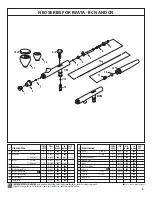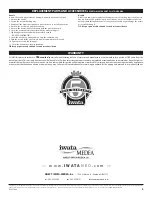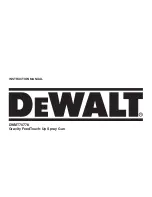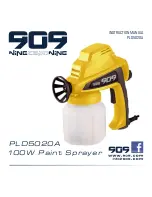
ASSEMBLY
TO COMPRESSOR
TO AIRBRUSH
TO COMPRESSOR
TO AIRBRUSH
CN GRAVITY-FEED
DUAL-ACTION AIRBRUSH
BCN SIPHON-FEED
DUAL-ACTION AIRBRUSH
Needle chucking guide
needle
main lever
color cup
needle cap
nozzle cap
bottle
attachment
handle
main lever
needle cap
nozzle cap
handle
air hose
air hose
Fine-Line Spray
1. Depress the main lever to start air flow.
2. Position the airbrush close to the surface, between 1/16 and 1/2 inch is common.
3. Pull the main lever back slightly to start the flow of paint.
Line thickness can be controlled by adjusting the distance between the airbrush
and the surface and also by varying the paint flow by manipulating the main
lever’s position.
Wide-Line and Background Spraying
1. Depress the main lever.
2. Position the airbrush further away from the surface, from 1 to 6 inches is common.
3. Pull the main lever back much farther releasing more paint to cover the bigger area.
Increase the distance between the airbrush and painted surface to control the line’s
width. Increasing the air pressure will also affect the spray width.
Air Pressure
For the NEO, working pressures generally vary between 10 and 60 psi, depending
on what type of work is being done and what textures are desired. A good working
pressure may average around 15-25 psi. The viscosity of the paint and your desired
spray characteristics will also affect your ideal pressure. As a general rule, larger
amounts of paint or thicker paints, will be sprayed with higher pressures.
WARNING: Do not exceed 100psi.
Paint Preparation
For non-airbrush-ready paints, proper preparation, including filtering the paint
through a nylon mesh, is recommended for best performance. Paint should be
thinned. It is best to prepare paint relatively thin and make repeated passes across
the work to achieve the desired shade. This will also improve the quality of your
work and decrease the cleaning time of your airbrush.
Safety Tips
• Always spray in a well-ventilated area.
• Use the appropriate respirator to safely filter out the paint vapors particular to the
kind of paint you are using.
• Wear eye protection to prevent paint contact with eyes.
• Never use air pressure that exceeds the airbrush’s limit (100 psi).
GENERAL OPERATION
REFER TO DIAGRAM ABOVE
Cleaning the Airbrush (BCN)
1. Remove the paint bottle.
2. Attach a bottle containing the appropriate cleaning solution.
(Note: Medea Airbrush Cleaner works great for water-based media.)
3. Spray until the solution sprays clear.
4. Remove the bottle of cleaning solution.
5. Spray air until the airbrush sprays dry.
6. Attach a bottle containing the next color.
7. Repeat cleaning procedure when finished.
Cleaning the Airbrush (CN)
1. Dump out the color cup’s excess paint.
2. Rinse the cup with the appropriate cleaning solution.
(Note: Medea Airbrush Cleaner works great for water-based media.)
3. Use a paper towel to wipe out any left-over paint.
4. Fill the bottom of the cup with cleaner.
5. Spray cleaner until the spray is clear.
6. Add the next color to the color cup.
7. Repeat cleaning procedure when finished.
Cleaning the Needle (BCN, CN)
Before removing the needle, clean the airbrush as recommended.
1. Unscrew the handle from the airbrush body.
2. Loosen the needle chucking nut.
3. Gently pull the needle straight out.
4. Fold a soft cloth damp with cleaner over the needle.
5. Rotate the needle to gently wipe the residual paint off.
6. Carefully insert the needle into the airbrush until it seats fully against the nozzle.
CAUTION: The most probable time to damage the needle is when the needle
passes through the main lever. If the needle stops abruptly, retract and examine
the trigger mechanism for proper assembly and re-insert the needle.
7. Tighten the needle chucking nut finger tight.
• Pull the main lever back and forth to visually confirm the needle’s ability to move.
8. Screw the handle back onto the airbrush body.
Before Each Session
Spray water or the appropriate cleaning solution through the airbrush to make
sure the airbrush is working properly.
After Each Session
Or any time the airbrush becomes clogged:
1. Increase the air pressure.
2. Spray cleaning solution for a short time.
3. Clean the needle if necessary.
Cleaning the airbrush this way helps clean the paint passage, the nozzle
and the needle thoroughly. Note: Prolonged use of solvents may cause the
solvent-resistant o-ring to swell.
Periodically
To ensure smooth main lever action lubricate the needle and the main lever
mechanism when necessary.
1. Unscrew the handle.
2. Loosen the needle chucking nut.
3. Remove the needle.
4. Coat the needle lightly at the front where the taper starts with a high-quality
lubricant, like Medea Super Lube.
5. Wipe the needle with a soft, clean cloth, leaving a light coat of lube behind.
6. Re-insert the needle gently into the airbrush.
7. Tighten the needle chucking nut.
8. Screw the handle onto the airbrush body.
Use a tiny drop of lube on the main lever’s piston. DO NOT over-lube the needle
or the main lever mechanism, since it is possible to transfer excess lube into the
nozzle causing severe paint flow problems. DO NOT use light machine oil or WD-40
for lubrication. These will cause the needle to stick as it moves through the needle
packing o-ring.
CAUTION: If it becomes absolutely necessary to dismantle the airbrush
remember that in most situations tools are not needed.
MAINTENANCE
REFER TO MASTER PARTS LIST ON PAGES 4
3























